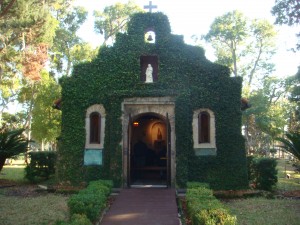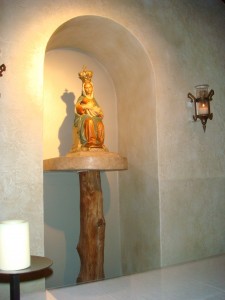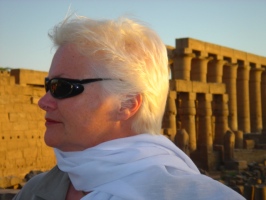
Shrine of Our Lady of La Leche
Published in 2011 Leaven Issue 2
The blustery drizzle of a January morning had thrown palm fronds on the ground and live oak leaves at my feet along winding dirt paths as I made my way away from the dry, quiet gift shop. And there it was, a building and a name that had guided my volunteer life for over 29 years. I entered the small, white-washed building with the red tile roof. As I now stood alone in the little room and many candles flickered with each stray gust of wind, I reflected on La Leche Leagues history and my own mothering journey since reading about this little shrine in my Leader Applicant days in the early 1980s. And now I was actually here. Giving myself the January birthday gift of two weeks of warmth and a Key West writing seminar, I had flown into Jacksonville, Florida, USA, and rented a car the day before. But St. Augustine and a bit of La Leche League history were my first stops.
St. Augustine is about an hour south of Jacksonville, and stretches north-to-south along Florida’s upper Atlantic coast. The Nombre de Dios Mission, Prince of Peace Catholic Church, Nombre de Dios Museum, and the shrine itself are on 20 acres of grounds in the northeast “uptown” end of this coastal stretch. Many antique shops line San Marcos Boulevard, so this area is also called “antiques row.”
This quiet, humble little sanctuary houses a modest status of Mary nursing baby Jesus, and, inspired a bas relief replica medallion that Dr. Gregory White used to give to his obstetrical patients in faraway Franklin Park, Illinois, in the 1940s and ’50s. As I had sat in my rental car in the gift shop parking lot, I reflected on how I’d told the story so many times and at so many Series Meetings. Now I stood alone in the room with guttering votive candles along the walls, my own La Leche League story, and this sweet little statue.
The Shrine, the Name, and the Inspiration
Starting with the original shrine (also sometimes referred to as a chapel) built after 1565, many reconstructions have been damaged in hurricanes and military attacks and then rebuilt. The present shrine was constructed in 1915.
The Shrine of Nuestra Senora de La Leche y Buen Parto–“Our Lady of Plentiful Milk and Good Childbirth” in the loose English translation–inspired the LLL Founders when they were looking for a name that did not include “breastfeeding” (thought to be too graphic a word for the 1950s). Dr. White suggested the alliterative, shrine-inspired “La Leche League.”
 This first and smallest Marian Shrine in the Americas is the jewel of the Nombre de Dios Mission grounds. Espaliered boxwood on the white outer walls and red tile on the roof protect the small stained-glass windows, which allows the Sunshine State’s rays to cast a swirl of colors on the whitewashed inner walls. Plain wooden benches and individual wooden seats stand along the walls. Though able to house perhaps 25 visitors, I recommend finding time alone in this small and intimate setting if you can arrange it.
This first and smallest Marian Shrine in the Americas is the jewel of the Nombre de Dios Mission grounds. Espaliered boxwood on the white outer walls and red tile on the roof protect the small stained-glass windows, which allows the Sunshine State’s rays to cast a swirl of colors on the whitewashed inner walls. Plain wooden benches and individual wooden seats stand along the walls. Though able to house perhaps 25 visitors, I recommend finding time alone in this small and intimate setting if you can arrange it.
St. Augustine and the Nombre de Dios Mission
Juan Ponce de Leon (Hwan POHN-cey day lay-OWN) was the first European to discover Florida in 1513 on an exploratory voyage from Puerto Rico. The Timucuan Indians who lived there stood 6 to 7 feet (1 to 2.1 meters) tall, so, compared tohis own 4-foot-11-inch (1.5-meter) stature, de Leon may have thought he had found the legendary Fountain of Youth and height. In 1565, a Spanish expedition, led by Pedro Menendez de Aviles (day ah-vee-LAYCE), landed and stayed. With that second expedition was Father Francisco Lopez de Mendoz Grajales (called “Father Lopez), who conducted America’s first Catholic Mass, founded the Nombre de Dios (Name of God) Mission, and began work on the first shrine. St. Augustine thus became the first permanent European settlement in the United States.
The statue
The present Nuestra Senora/Our Lady of Leche statue is 18 inches tall (45.72 cm, including the crown), was created in the 1970s, and has been recently cleaned and renovated. It sits in a carefully spotlighted niche on the south wall of the shrine. Two older versions of the statue are housed in the nearby museum. Director Eric Johnson commented that the `930s statue seems to show the most skin. The bookmark I bought in the gift shop appears to show the 1970s statue.
The Lagoon, Bridge, and Grounds
The shrine grounds are bordered by Hospital Creek on the east, Ocean Avenue on the north, San Marcos Boulevard on the west, and Pine Street on the south. The current incarnation of the La Leche Shrine was built in 1915 but has its roots in a fourth century grotto in Bethlehem in what is now Israel. This “Milk Grotto” is maintained today by the Franciscans.
A 208-foot (63.4 meters) “Great Cross” stands on the shores of Hospital Creek and is an artwork second in height only to the 630-foot-tall (192 meters) Gateway Arch in St. Louis, Missouri, USA. Near the cross, a statue of Father Lopez reaches to the sky, one of several statues scattered throughout the grounds.
On the footbridge over the lagoon, couples and families were taking photographs. Herons, egrets, ducks, pelicans, and wood storks alternatively preened themselves along the banks, stretched in the sun, dove for fish, and perched on the bridge railings. Frequent rain, dew, and tropical humidity ensure a lush landscape and constant pruning of tree limbs and picking up of fallen palm fronds. The cedars, various palms, ferns, and live oaks draped with Spanish moss provide an intense green setting for the little white shrine.
Gift shop, museum, and church
Friendly clerks sell many religious items in the gift shop including sterling silver and aluminum medals; silver, crystal, and wood rosaries; La Leche statue replicas in bisque, plaster, and resin; memento boxes; bookmarks; Mother’s Manual prayer books; and postcards. The Nombre de Dios Museum opened in September 2010 and houses two older Nuestra Senora statues. The Prince of Peace Catholic Church actively serves the parish. As I looked at the gift shop’s many religious items included with the La Leche medallions, I was struck again with admiration at the courage it must have taken for the Founders to decide to make La Leche League a nonsectarian organization.
My quiet contemplation in the shrine that day was soon broken by the voices of other tourists and parishioners, so I reluctantly went back outside into the wuthering, swirling weather. As I took photographs to share with my co-Leaders back in Utah, I slowly walked the paths outside and around this modest little shrine. And, perhaps without realizing how much I needed this journey, I felt that my own paths and my own way through motherhood and offering mother-to-mother support had been rekindled and rejuvenated for a lifetime.

One Comment